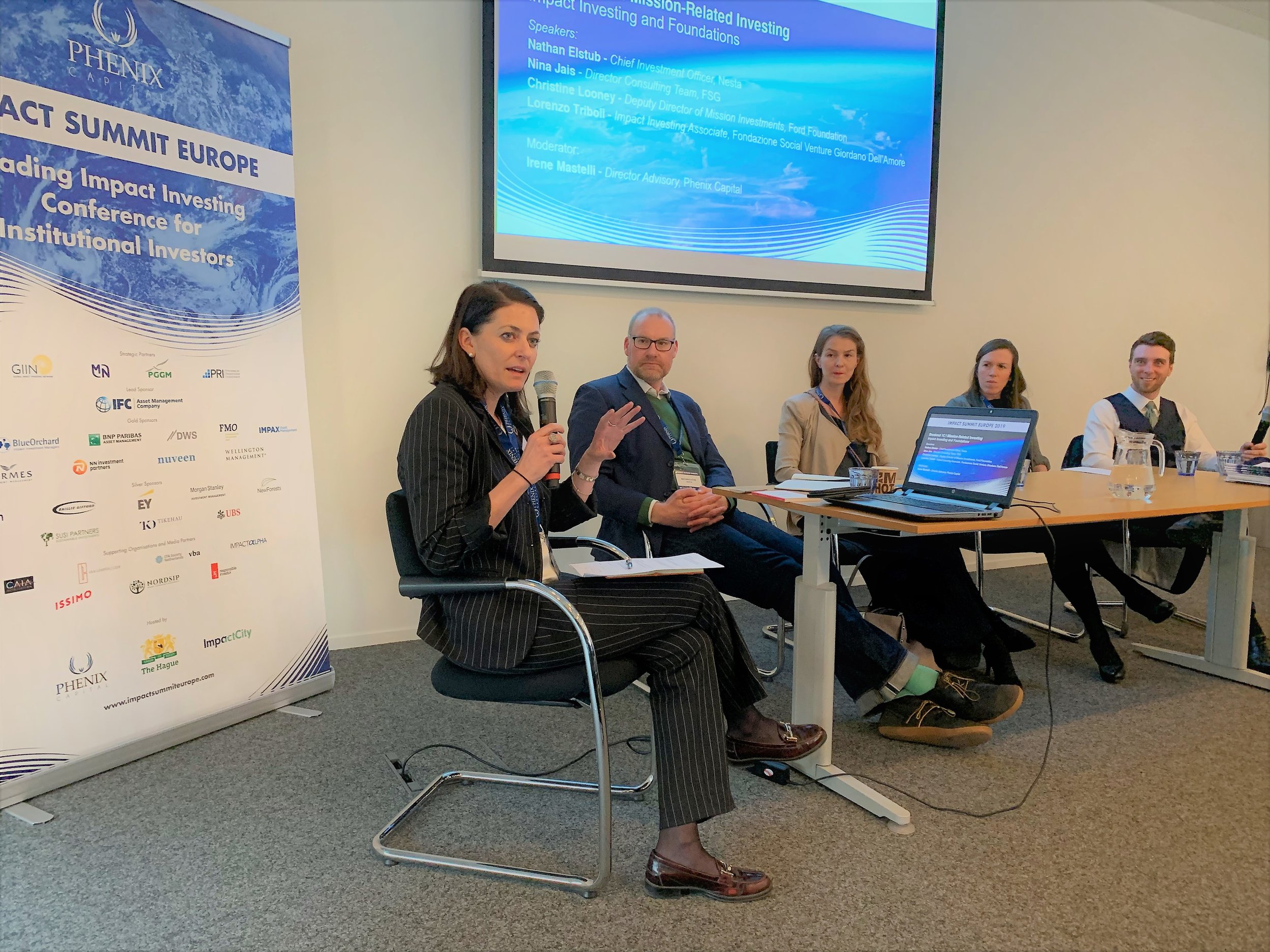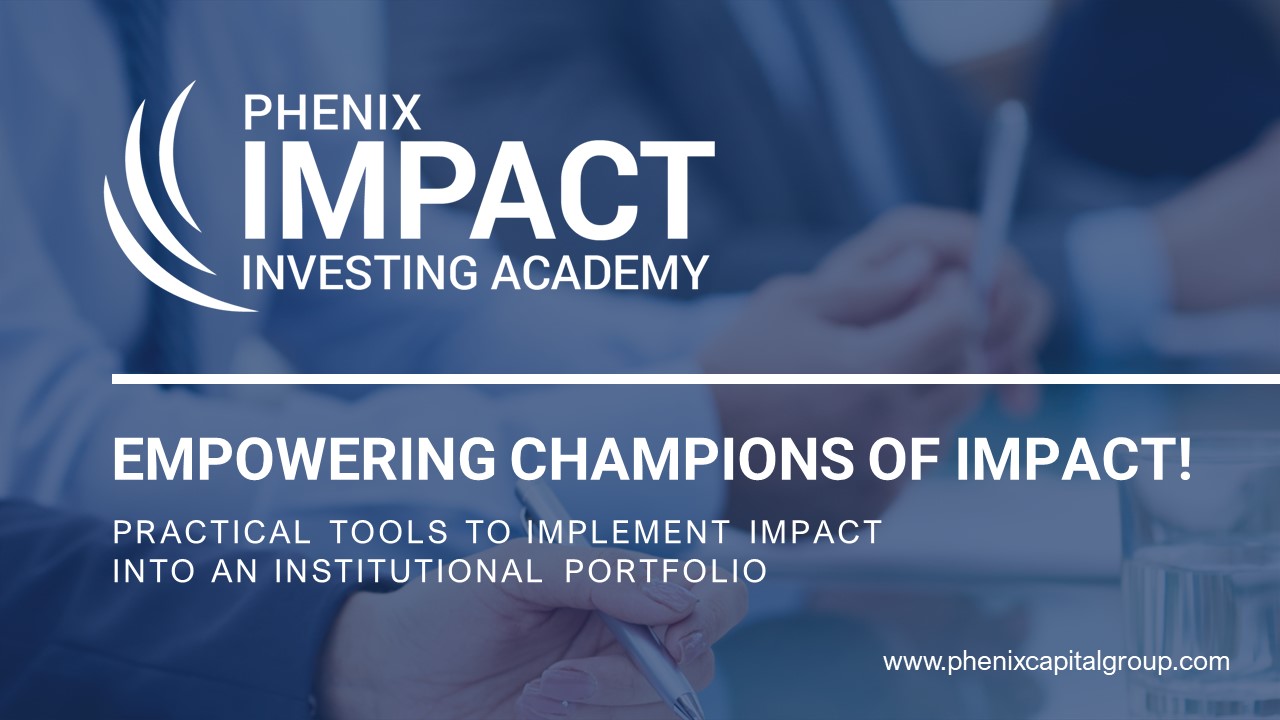1 min read
PRESS RELEASE: Phenix Capital Group announce Impact Investing Academy
Launching the Phenix Impact Investing Academy – Empowering champions of impact!Amsterdam, 11 August 2023 – Phenix Capital Group is launching the ...

We start this blog series with the topics presented at Impact Summit Europe (April 2-3 in the Hague), providing a summary of the discussions together with our thoughts. We start with the session ‘ Impact Investing and Foundations on the role of Mission-Related Investing (MRI)’.
Aligning an investment portfolio with an institution’s values is a growing trend, particularly for foundations. These institutions often have well-defined goals and missions, and as a result they can more easily determine what fits well in the portfolio, what does not fit, and what is positively contributing to the foundation’s mission. Families – particularly when they are more involved in managing the portfolio – also have an easier time defining what they stand for and judge their holdings through this lens, rather than only through the traditional lenses of expected risk and return. But let’s start with some definitions. It is important to highlight regional differences and as well as the different ways in which program- and mission-related investing are used.
In the U.S. program-related investing, or ‘PRI’, is defined under U.S. tax law as an investment whose primary purpose is “to accomplish the foundation's exempt purposes”. In the panel at Impact Summit Europe, Ford Foundation provided examples such as investing in first time managers and strategies (i.e. unproven as a portfolio management team, or new to a strategy) which tend to bear a higher risk. These program-related investments count towards the required 5% spending. Mission-related investing, or ‘MRI’, pertains to the rest of the portfolio – or the other 95% of the endowment – where the Foundation makes market-rate investments (i.e. with returns comparable to those available via traditional instruments), but with the goal to also achieve social impact. In line with their main mission of greater social justice, Ford Foundation invested in social housing in the U.S., aiming at social good and market-rate returns.
The goal of Nesta, a U.K. foundation whose mission is to support innovation for public benefit, is to create an environment for impact investments. Within Nesta it is an operating charity – not the main fund – that took on the endeavour, as stakeholders deemed it too risky to tackle it using the main portfolio, which remains focused on generating returns. The ambition for many is to use what they learned making program-related investments – using the capital available for the foundation’s spending or grants – to also align the portfolio of the endowment. A maturing impact investment market can achieve that – to showcase how market-rate returns can be obtained at the same time as generating a positive social or environmental impact.
Fondazione Social Venture Giordano Dell’Amore presents similarities with Nesta as the Foundation (part of Fondazione Cariplo, one of the largest foundations in Italy) was created to foster the growth of the impact investing ecosystem in Italy. The Foundation’s endowment is put to work to through both direct and indirect equity investments into businesses tackling relevant social and environmental challenges in Italy with sustainable and innovative business models. The Foundation applies a social venture capital approach with an “impact first” focus, leveraging patient capital to support innovation in different economic sectors including welfare, environment, social services & integration, arts & culture, sustainable tourism, and more.
FSG, a mission-driven strategy firm set up as an NGO, helps corporations and foundations to bring impact at scale and developed a framework to explore the continuum of market-rate or commercial investments, sub-commercial investments, and grants. Their idea, which is also the name of their project, is to move “beyond trade-offs”, or give up the notion that to achieve impact one must give up returns, or vice versa, that market rate investments cannot achieve impact goals. At times sub-commercial capital is needed as a bridge or – as we have seen in the case of Nesta and Giordano dell’Amore – to build capacity and create an impact investing ecosystem.
When discussing mission-related investments – or using the portfolio to also generate impact – questions pertaining to fiduciary duty tend to arise: What impact is expected? Are other investments available targeting a higher return? What is the risk? With a mandatory spending rate of 5% U.S. foundations target high returns (typically an expected return of 7%, assuming 2% inflation rate, to ensure the endowment’s perpetuity). Hence, they need to weigh the benefits of mission-related investments against the duty to also generate high returns. Ford Foundation spoke about combining an assessment of risk alongside that on the expected return.
The discussion on the topic of mission-related investing then naturally turned to impact measurement – if the goal of an investment is also impact, then measuring it is necessary. Unfortunately, some investors are discouraged by the lack of standards and tools. Nesta described the process of narrowing down measurements to a few key metrics and only investing where there is a sufficiently high potential to achieve the desired outcomes. Fondazione Giordano dell’Amore spoke about the creation of an “evaluation lab” dedicated to measuring impact but conceded that greater diversification, and in their case in several different ventures, can make it complicated to measure and aggregate results.
To summarise, it is possible to invest in line with an institution’s mission. Doing so requires some degree of soul searching, conversations with stakeholders, and understanding of key risks. Program-related investments, that are funded by spending and founded via the investment portfolio, have been designed to foster an impact ecosystem and have consequently provided the soil upon which to build mission-related programs. The measurement of impact can be tricky, but it should not discourage investors from trying their hand at investing in alignment with their mission.
In the next posts, Phenix Capital will take a more in-depth look at related topics such as impact measurement and outcomes-funds. Stay tuned!

1 min read
Launching the Phenix Impact Investing Academy – Empowering champions of impact!Amsterdam, 11 August 2023 – Phenix Capital Group is launching the ...
.png)
Amsterdam, April 10, 2020: Our team at Phenix Capital are thrilled to announce that the 2020 Global Impact Platform Fund Report: A market map for...

Momentum is gathering pace within European institutional investors as they are increasingly committing money to impact and SDG financing. Europe, led...